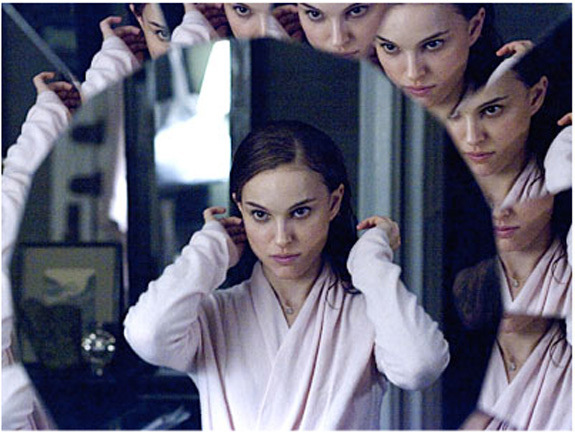Review: Black Swan
Darren Aronofsky’s “Black Swan” will leave a myriad of lasting impressions on different people for different reasons, but universally, the film will prove to the masses that ballet is most definitely not boring. Beautiful, thrilling, breathtaking — yes, I’m referring to both the art form and the film. “Black Swan” echoes everything there is to love about both art forms: the passion, the elegance, the drive to create something deep and moving. Aronofsky’s film is every bit as graceful as the art form and culture it seeks to capture, but more noticeably, every bit as challenging and dark and uncomfortable.
Although Aronofsky’s name has the reputation attached because of his visceral, deeply emotional and borderline distressful filmmaking style (“The Wrestler,” “Requiem for a Dream”), the spotlight belongs on star Natalie Portman as the film’s first image so appropriately conveys. “Black Swan” is her story, a partial allegory for the ballet she’s working on (“Swan Lake”), but more so a piercing journey into the mind of a sheltered and innocent young woman whose quest for perfection plunges her into a psychologically state that she cannot comprehend.
Portman plays Nina Sayers, a ballerina in New York’s finest company whose dedication to her craft is never compromised (need I point out her name rhymes with ballerina?). Her success is partly thanks to her mother (Barbara Hershey), whom she still lives with and who literally mothers her to a ridiculous extent, but has kept her focused and out of trouble. Hershey plays the part carefully, not lapsing into clichéd overprotective mother territory too much, with a bit of help from the script not overdoing it as well.
Nina’s dedication and innocence have finally appealed to her instructor/the company’s artistic director, Thomas (Vincent Cassel), who casts her as the coveted role of Swan Queen, which combines both parts of White Swan and Black Swan to make an artistic point about duality (and the film more interesting). Thomas tells Nina she’s the quintessential White Swan, the innocent, picturesque dancer, but that she possesses no qualities of the seductive and fluid Black Swan. He believes in her, however, and is attracted (somewhat inappropriately) to her, so while he’s given her the part, she still has to “earn” it.
Nina’s quest to become the Black Swan, to divorce herself from the sheltered lifestyle that has wound her so tightly so she can convincingly do the Black Swan dance, is the center of the drama. This is accompanied by a mysterious “transformation” she appears to be undergoing into an actual swan along with times when she’s on the subway or other places and she sees herself. The suspenseful elements grow from subtle tension to full-blown horror as the film goes on and the pressure mounts for Nina to succeed. At times the “scares” feel extreme, but the horror complements the poise and elegance of the ballet nicely. In fact the two work harmoniously at times, especially thanks to Clint Mansell’s Tchaikovsky-twisting score.
Seeing as Aronofsky enjoys seizing the opportunity to make his audience uncomfortable, the horror should come as no surprise and neither should the pervasive sexuality of the film. Nina must learn to feel not think, to be seductive in her movement, and so the sexual ties to that are inherent (and arguably forced in at times). When Mila Kunis enters the picture as Lily, a fellow dancer who embodies the Black Swan characteristics Nina so desperately wants (she does drugs, sleeps around, eats cheeseburgers), a thick layer of sexuality drops onto the story. Overall, there’s quite a bit of female sexuality, which despite how far movies have come, still has a taboo on it more so than male sexuality, so it does distract from its point at time. By and large, however, Aronofsky keeps these scenes pertinent and meaningful.
In the perspective of the entire film, however, sexual tension marks just one of numerous tensions that Aronofsky constantly weaves under the plot. Every scene has layers of text and subtext to make the scenes that don’t have a fantastical element to them equally gripping. Aronofsky and Portman are the real dance partners here, working together to make what’s beneath the surface an equal player in the viewing experience as well as to reflect — quite literally with all the mirrors — the levels of turmoil in Nina’s mind.
Portman’s performance ranks heads and tails above all her previous work. The overprotected child who is rigid and naive could be seen as an archetype, but Portman convinces us of Nina’s reality by taking all these attributes to her core. Her emotions, like her in-tears excitement over getting the part of Swan Queen when she calls to tell her mom, are so convincing. We identify with her mixed feeling of excitement, fear and doubt among others and her performance communicates all those emotions stewing together inside her. Considering that “Black Swan” seriously features her performance if not hinges on it, her success cannot be overstated.
Nina’s pursuit of perfection, to embody both sides of the coin instead of being the best at one side, will relate to everyone who has ever dared to be really good at anything challenging. The circumstances and results of Nina’s particular story are stretched for dramatic effect, but Portman’s performance remains so convincing throughout and Aronofsky’s direction every bit as masterfully artistic that “Black Swan” deserves some of the highest of the praise that will go around in 2010. The film achieves the rare poetic synergy between the music, ballet, acting and direction that leaves you thinking a lot about what you just saw.
—
4.5/5 Stars
—
Black Swan
Directed by Darren Aronofsky
Written by Andres Heinz, Mark Heyman and John J. McLaughlin
Starring: Natalie Portman, Vincent Cassel, Mila Kunis, Barbara Hershey





0 Comments
You can be the first one to leave a comment.